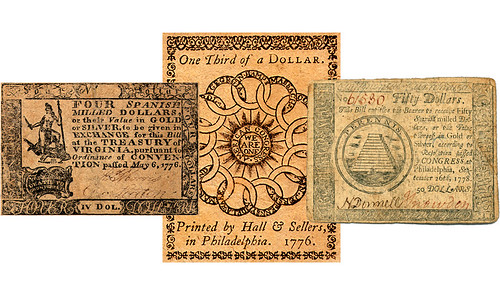
PREV ARTICLE
NEXT ARTICLE
FULL ISSUE
PREV FULL ISSUE
BRITISH COUNTERFEITING IN COLONIAL AMERICA
Chip Howell forwarded this article from the Journal of the American Revolution (JAR) on British counterfeiting during the American
revolution. Thanks! -Editor

The American Revolution was very much a case of David versus Goliath. A relatively small group of colonists decided that they wanted to break free of the home government, which in this case just happened to be one of the most powerful nations on the globe. Almost overnight the thirteen separate colonies had to form a central government to unify the people, a military to defend the people and a central economy to pay for it all. It was a daunting task that had to be accomplished while undergoing an invasion by the British army, which would continue to make mincemeat out of whatever forces the Americans could throw at it. The British army, however, had just as many uphill battles to fight. Lack of men and supplies, a chain of command that stretched almost three thousand miles, and a population in the colonies that could range from hostile to very supportive to outright ambivalent. For the British army, meeting the Americans on the field of battle would lead to many victories, but never any that would bring an end to the war. Something besides the force of arms would be needed to bring the colonies to their senses. To this end a campaign was devised to undermine the nascent American economy in an attempt to achieve a twofer. If the economy was in shambles the Americans would not be able to purchase the men and material needed to continue the war. At the same, by undermining the economy they would also be undermining the American Congress, which was acting as the central government. Perhaps if people lost faith in the Congress, they would realize that war could not be won, and they would all return to the fold. While it is hard to say whether anyone in the British government sat down and actually put together a comprehensive plan, it is obvious that several different measures were undertaken. These included attempts to limit American trade with foreign nations using the all-powerful British Navy to interdict as much overseas commerce as possible as well as searching vessels from “neutral” countries for war materials in route to America. This move in particular was frowned upon by many European nations. While these activities were effective to a point, the most effective strategy that was tried, and one that very nearly succeeded, was the massive undertaking of counterfeiting Congressional paper currency to the point of making it almost worthless, thus crashing the American economy. No economy, no more war. In looking at this strategy three questions must be asked: How were the fake notes produced and circulated? Was it effective in undermining the economy? Finally, was this a sanctioned strategy by the British, one that they knowingly pursued? Looking at the counterfeiting strategy through these questions presents an intriguing, and often overlooked aspect of the American Revolution. For the majority of the war the city of New York was under control of the British. It was here that the majority of the counterfeiting was done. For the most part it was not difficult as many of the advanced security measures that are used today to dissuade such actions were not in use. Even though bank notes had individual handwritten serial numbers and signatures, these were no deterrent as they were easily forged. In addition, most of the Continental currency that was printed by legitimate services was done on the cheap, with little eye to quality. This made the process of counterfeiting it much easier. Often the fake currency could be easily spotted because it was of higher quality than the legitimate bills. The paper was usually a higher quality and the engraving was of a much higher quality on the professionally done counterfeits. One thing that set the legitimate currency apart was the special paper used, common paper infused with blue fibers and flakes of mica that set it apart from normal paper (a similar method is used today, which makes it much harder to simply photocopy a hundred dollar bill and spend it at the local grocery store). While the paper itself was special it was far from rare. In fact at one point British ships were intercepted on their way to New York that were found to be carrying not only the ink for counterfeiting but massive amounts of the paper. The American frigate Deane, on August 9, 1779, captured the Glencairn out of Glasgow. The report of Commodore Samuel Nicholson of the Deane to the Continental Congress, as published in the Virginia Gazette of October 2, 1779, stated:
On board the Glencairn, a person says he had in charge a box, which was to be delivered to some person in New York, but upon our coming
up with them and the ship striking, threw it overboard; upon which we went immediately after it, and with difficulty got it before it
sunk, when upon examination we found it contained materials for counterfeiting our currency, consisting of types, paper with silk and
isinglass in it &c. We have however determined to secure the person, as we believe him to be the sole intender of the villainy: The box
we have on board and shall bring it with us to Boston.
To read the complete article, see:
Wayne Homren, Editor The Numismatic Bibliomania Society is a non-profit organization promoting numismatic literature. See our web site at coinbooks.org. To submit items for publication in The E-Sylum, write to the Editor at this address: whomren@gmail.com To subscribe go to: https://my.binhost.com/lists/listinfo/esylum All Rights Reserved. NBS Home Page Contact the NBS webmaster 
|